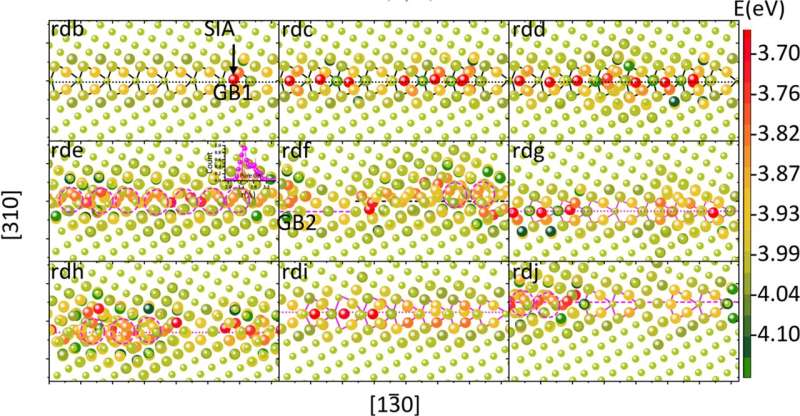
A research team led by Prof. Liu Changsong from the Hefei Institutes of Physical Science of the Chinese Academy of Sciences has developed a set of simulation software for accumulative displacement damage in nanocrystalline metals, which was named iterative object kinetic Monte Carlo (iOKMC).
Using this software, the research team carried out a series of studies on the accumulation mechanisms of displacement damage in iron (Fe)-based nanostructured materials. Relevant results were published in the Journal of Nuclear Materials.
Nanocrystalline Fe was found to exhibit improved radiation resistance. This benefits from the high density of grain boundaries (GBs) which serve as sinks for radiation induced vacancies (Vs) and self-interstitial atoms (SIAs). However, previous multiscale simulations only focused on the basic atomic processes when exploring the microscopic mechanisms of defect-GB interactions, making it powerless to obtain new physical processes that may be introduced by the accumulative damage.
The technique developed in this study not only enables radiation doses and dose rates in experiments, but also complements and corrects existing atomic processes based on radiation doses.
The researchers investigated the accumulation mechanisms of radiation defects at Fe GBs, mainly including the SIAs loading in GBs at a low temperature and its effects on the role of GBs under radiation. The results suggested that the SIAs preferentially segregate to the GB at a high dose rate and/or a low temperature.
As the radiation dose increases, the SIAs accumulated on the GB become structural components of the GB and further restore the GB to its background structure. This process involves a minority transition of some excess SIAs to Vs, accompanied by a local motion of the GB.
With the accumulation of SIAs, the role of the GB exhibits an alternating evolution from trapping Vs to annihilating Vs. When the new atomic processes were re-parameterized and incorporated into the original OKMC model, it was found that the concentration of SIAs at the GB and the concentration of Vs near the GB had an alternating trend of “increase-decrease”, which was different from the original simulation results.
This study presents a cross-scale pattern for exploring the dynamic interaction mechanisms between radiation defects and GBs under accumulative radiation, providing a mechanism reference for further optimizing the radiation resistance of polycrystalline materials based on GB engineering.
More information:
Xiangyan Li et al, Radiation damage accumulation mechanisms at iron grain boundaries revealed by coupled atomic and coarse-grained simulations via the parameter-passing and structural feedback, Journal of Nuclear Materials (2022). DOI: 10.1016/j.jnucmat.2022.154092
Provided by
Chinese Academy of Sciences

READ MORE
When the Bison Return, Will Their Habitat Rebound?
On a blustery October afternoon at the Wolfcrow Bison Ranch in southern Alberta, Canada, Dan [...]
Are people who win the lottery really any happier?
Are people who win the lottery any happier? That’s not so easy to determine. © [...]
Drought Caused These 6 Famous Waterfalls to Dry Up
Victoria Falls on the Zambezi River in southern Africa can slow to a relative trickle [...]
35 Who Made a Difference: Douglas Owsley
Wikimedia Commons For a man who has toiled amid some of the most horrific circumstances [...]
Why Is the Tropic of Capricorn Important?
The Tropic of Capricorn sign in Namibia, Africa. Between Sossusvlei and Walvis Bay in Namibia, [...]
Do Teachers Need Their Own “Bar Exam”?
Do teachers need to train more like doctors? Photo courtesy of Flickr user WoodleyWonderworks Question: [...]
Top 10 Things to Recycle at Your Construction Site
Construction and demolition waste are the largest sources of trash in the United States. See [...]
Are the Polar Ice Caps Melting Faster Than We Thought?
Antarctica accounts for about 90 percent of the world’s ice. Tom Brakefield/Getty Images The global [...]